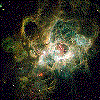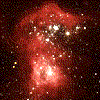
Giant Starbirth Region In Neighboring Galaxy
This is a Hubble Space Telescope image (right) of a vast nebula called NGC 604, which lies in the neighboring spiral galaxy M33, located 2.7 million light-years away in the constellation Triangulum.
It's like Orion nebula of our Galaxy, but this one is particularly large, nearly 1,500 light-years across.
At the heart of NGC 604 are over 200 hot stars, much more massive than our Sun (15 to 60 solar masses). They heat the gaseous walls of the nebula (17,000 degrees Fahrenheit, 10,000 degrees Kelvin) making the gas fluoresce.
